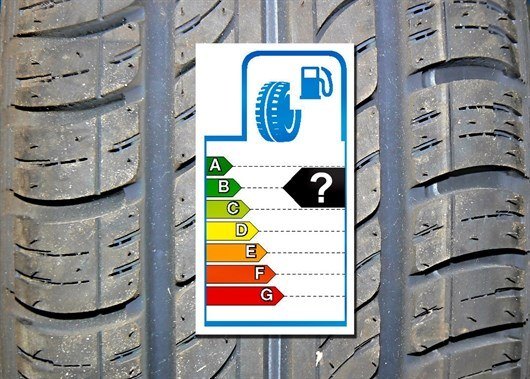Michelin campaigns for introduction of worn tyre ratings

Michelin is calling for the introduction of worn tyre ratings after it emerged that wet braking distances for some tyres can exceed 60 metres when the tread depth approaches 1.6mm.
Under current EU rules, tyres are measured for noise, rolling resistance and wet weather performance when they're new and typically have 7mm of tread depth. The ratings, which span A - F, indicate a wet braking distance of three meters between each category. This means a car with a set of A-rated tyres will 18 metres shorter than one on F-rated tyres.
When should you replace the tyres on your car?
However, Michelin says that the EU system is unreliable as wet braking distances can vary dramatically as a tyres becomes worn.
“We want a minimum performance standard for all tyres. This means testing tyres when they're new (7mm) and when they're worn to the 1.6mm tread limit.” said Cyrille Roget, technical communication manager of Michelin.
“Tyre compounds and performance levels change over time and it can be very difficult for drivers to understand how much wet grip they will get from a tyre as it becomes worn. Likewise fuel economy also changes and a worn labelling system would make it easier for everyone to understand whole life tyre performance. We already have plans to implement such a system for all of our products."

Michelin claims to have tested 26 different tyres from across the market. The research, which isn't in the public domain, shows that wet braking distances for some tyres can exceed 60 metres. Michelin also claims that the stopping distances for tyres with the highest rating - A for wet grip - can double when they're worn. Michelin believes this has created a culture of waste as drivers are often asked to replace their tyres long before they reach the 1.6mm tread depth.
“We have found that most drivers replace their tyres at 3mm and this produces a huge amount of waste because a tyre requires an enormous amount of raw materials and energy to be produced. As an industry, we think 400 million tyres and 35 million tonnes of CO2 could be saved if drivers had the knowledge and confidence to run their tyres to the legal limit."
EU tyre labels were introduced in 2012 to make it easier for drivers to understand performance, with each one showing how the tyre has tested for fuel economy, noise and wet weather grip. However, Roget says the labelling system needs to be expanded to allow drivers to make the most informed decisions when it comes to choosing the right tyres for their needs. Industry test bodies and consumer organisations would also need to start comparing and tested tyres when they're worn to the limit.
“Safety is a result of overall performance, not just tread depth," said Roget. "Our tyres are designed to work right down to 1.6mm. As a result, we tell our customers that they shouldn’t replace Michelin tyres until they reach the limit. Sadly not all tyres perform in this same way. That's why we want to see a new rating system and performance standard for worn tyres."

 Dan Powell
Dan Powell
 Honest John Awards 2017: Land Rover Discovery Sport named Most Popular SUV for second year in a row
Honest John Awards 2017: Land Rover Discovery Sport named Most Popular SUV for second year in a row
 2022 Smart #1 SUV: price, specs and release date
2022 Smart #1 SUV: price, specs and release date
 2023 Ferrari Purosangue SUV: Prices, specs and release date
2023 Ferrari Purosangue SUV: Prices, specs and release date
 Citroen DS3 Racing revealed
Citroen DS3 Racing revealed
 Infiniti adds diesel to the range
Infiniti adds diesel to the range
 Volvo XC90 chosen as SUV of the year at 2014 Honest John Awards
Volvo XC90 chosen as SUV of the year at 2014 Honest John Awards
 March new car registrations better than expected
March new car registrations better than expected





.jpg)






Mike Lanc on 15 May 2017
I fully agree with Michelin's thoughts. The present idea of 3 mm being a minimum safe limit is probably based on tests with vehicles where all 4 tyres are equally worn. Why does braking distance increase on wet roads increase as the tread gets shallower? I presume it is because the risk of aquaplaning increases. If this is so, let us not forget that the rear tyre usually follows the path of the front tyre. The front one will of course have removed most of the surface water, so the rear tyre runs over a damp, rather than water covered surface. It should therefore be less susceptible to aquaplaning and still safe with the 1.6 mm tread. So, when the front tyres are worn down to about 3 mm, move them to the back to finish them off and fit new front ones. The tread depth of a new tyre is 8 mm (I think), so a 3 mm replacement policy means that you use 5 mm. Extending the wear limit to 1.6 mm as I suggest would give 6.4 mm use, that is an extra 28% life from the tyres.Vivien Barber on 15 May 2017
I thank Michelin for their researches. Last year, my Audi garage said that two of my [Michelin] tyres were down to 4mm and that I should replace them, nagging me by phone later. Michelin had recently put out a Press statement basically saying that it was not necessary at 4mm, even anti-ecological to replace them. So I did not; they stayed on for another year, passed the MOT [44000 miles] and were then replaced. I drove with awareness.Michelin, please go on with your researches and I'll continue to buy your tyres.
Mike Lanc on 16 May 2017
It could be down to targets.Last year when my Peugeot was serviced, I was advised that one of the rear tyres needed urgent replacement. When I went to pick the car up. they already had a quote for a replacement. I did not accept their advice. Three months later, the same garage did an MOT and made absolutely no comment about the tyres. However, while I was waiting for the car, I saw a to-do board in one of the offices and it clerarly listed targets for fitting new tyres. Incidentally, my tyres are Michelin and the one they quoted was from A.N. Other manufacturer. Had I followed their advice, I would have had tyres of different make and levels of wear on the same axle. That does not sound like the best approach to road holding does it?
JOHN HELLIER on 16 May 2017
I would echo the above, again my experience was Audi 'encouraging' me to replace at about 4mm which I ignored. (Audi are a bit 'pushy' on a lot of stuff aren't they..?)So, I have run my Michelin's down to approaching 2mm, getting another 10k miles out of them i reckon, including getting through the MOT.
Whether I would have such confidence with other manufacturers I don't know....
I should say I used to work for Michelin a long, long time ago, so I'm biased :)
Brittany M on 18 May 2017
Moving front tyres to the rear only works if they are the same size. The rear tyres on my Merc. C Class are larger than the fronts.Add a comment